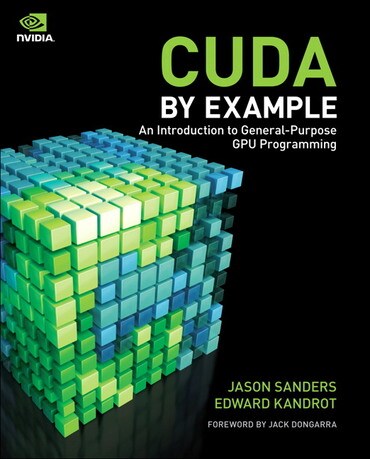
- Jason Sanders |
- Edward Kandrot |
Title overview
CUDA by Example, written by two senior members of the CUDA software platform team, shows programmers how to employ this new technology. The authors introduce each area of CUDA development through working examples. After a concise introduction to the CUDA platform and architecture, as well as a quick-start guide to CUDA C, the book details the techniques and trade-offs associated with each key CUDA feature. You’ll discover when to use each CUDA C extension and how to write CUDA software that delivers truly outstanding performance.
Major topics covered include
- Parallel programming
- Thread cooperation
- Constant memory and events
- Texture memory
- Graphics interoperability
- Atomics
- Streams
- CUDA C on multiple GPUs
- Advanced atomics
Table of contents
Foreword xiii
Preface xv
Acknowledgments xvii
About the Authors xix
Chapter 1: Why CUDA? Why Now? 1
1.1 Chapter Objectives 2
1.2 The Age of Parallel Processing 2
1.3 The Rise of GPU Computing 4
1.4 CUDA 6
1.5 Applications of CUDA 8
1.6 Chapter Review 11
Chapter 2: Getting Started 13
2.1 Chapter Objectives 14
2.2 Development Environment 14
2.3 Chapter Review 19
Chapter 3: Introduction to CUDA C 21
3.1 Chapter Objectives 22
3.2 A First Program 22
3.3 Querying Devices 27
3.4 Using Device Properties 33
3.5 Chapter Review 35
Chapter 4: Parallel Programming in CUDA C 37
4.1 Chapter Objectives 38
4.2 CUDA Parallel Programming 38
4.3 Chapter Review 57
Chapter 5: Thread Cooperation 59
5.1 Chapter Objectives 60
5.2 Splitting Parallel Blocks 60
5.3 Shared Memory and Synchronization 75
5.4 Chapter Review 94
Chapter 6: Constant Memory and Events 95
6.1 Chapter Objectives 96
6.2 Constant Memory 96
6.3 Measuring Performance with Events 108
6.4 Chapter Review 114
Chapter 7: Texture Memory 115
7.1 Chapter Objectives 116
7.2 Texture Memory Overview 116
7.3 Simulating Heat Transfer 117
7.4 Chapter Review 137
Chapter 8: Graphics Interoperability 139
8.1 Chapter Objectives 140
8.2 Graphics Interoperation 140
8.3 GPU Ripple with Graphics Interoperability 147
8.4 Heat Transfer with Graphics Interop 154
8.5 DirectX Interoperability 160
8.6 Chapter Review 161
Chapter 9: Atomics 163
9.1 Chapter Objectives 164
9.2 Compute Capability 164
9.3 Atomic Operations Overview 168
9.4 Computing Histograms 170
9.5 Chapter Review 183
Chapter 10: Streams 185
10.1 Chapter Objectives 186
10.2 Page-Locked Host Memory 186
10.3 CUDA Streams 192
10.4 Using a Single CUDA Stream 192
10.5 Using Multiple CUDA Streams 198
10.6 GPU Work Scheduling 205
10.7 Using Multiple CUDA Streams Effectively 208
10.8 Chapter Review 211
Chapter 11: CUDA C on Multiple GPUs 213
11.1 Chapter Objectives 214
11.2 Zero-Copy Host Memory 214
11.3 Using Multiple GPUs 224
11.4 Portable Pinned Memory 230
11.5 Chapter Review 235
Chapter 12: The Final Countdown 237
12.1 Chapter Objectives 238
12.2 CUDA Tools 238
12.3 Written Resources 244
12.4 Code Resources 246
12.5 Chapter Review 248
Appendix A: Advanced Atomics 249
A.1 Dot Product Revisited 250
A.2 Implementing a Hash Table 258
A.3 Appendix Review 277
Index 279
Author bios
Jason Sanders is a senior software engineer in the CUDA Platform group at NVIDIA. While at NVIDIA, he helped develop early releases of CUDA system software and contributed to the OpenCL 1.0 Specification, an industry standard for heterogeneous computing. Jason received his master’s degree in computer science from the University of California Berkeley where he published research in GPU computing, and he holds a bachelor’s degree in electrical engineering from Princeton University. Prior to joining NVIDIA, he previously held positions at ATI Technologies, Apple, and Novell. When he’s not writing books, Jason is typically working out, playing soccer, or shooting photos.
Edward Kandrot is a senior software engineer on the CUDA Algorithms team at NVIDIA. He has more than twenty years of industry experience focused on optimizing code and improving performance, including for Photoshop and Mozilla. Kandrot has worked for Adobe, Microsoft, and Google, and he has been a consultant at many companies, including Apple and Autodesk. When not coding, he can be found playing World of Warcraft or visiting Las Vegas for the amazing food.